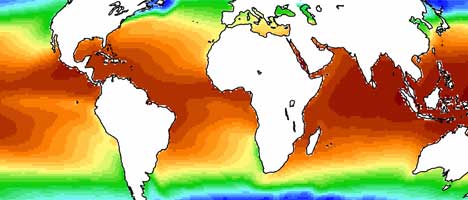Large-scale Ocean Dynamics
Changes in the large-scale ocean circulation, such as the Atlantic Meridional Overturning Circulation (AMOC), have a profound impact on global and regional climate systems, including Sahel and Indian summer monsoon rainfall, Atlantic hurricane activities, and Arctic climate. The large-scale ocean dynamics have played a key role in modern and paleoclimate change and low-frequency variability in coupled ocean-atmosphere systems. Understanding the dynamics of large-scale ocean circulation is crucial for the prediction of low-frequency climate variability and future climate change, especially abrupt climate change. Large-scale ocean dynamics also have an important influence on the uptake of heat and carbon dioxide by the ocean, and global biogeochemical cycling.
GFDL Research
One focus of GFDL’s research is the dynamics of large-scale ocean circulation, such as AMOC, and its climate implications. Examples of GFDL research in this area are described below.
Modeling Biases in AMOC:
Recent research at GFDL mapped the AMOC’s upwelling pathways as it moves water northward through the Atlantic and found that much of the northward flow is brought up to the surface in the narrow upwelling zones off the coast of Africa (Toggweiler et al., 2019a,b). This helps explain why much of the northward flow is at the surface as the AMOC exits from the tropics off Florida. A parallel simulation of the surface 14C in GFDL’s coupled model CM2Mc (Galbraith et al., 2011) found that very little of the northward flow in the model is brought up to the surface in the tropics, as observed. This is not surprising as these upwelling zones are not resolved very well in current climate models. The missing upwelling has important implications for the northward heat transport in climate models.
GFDL scientists have examined the sensitivity of the AMOC and water masses to biases in the convergence of moisture into the basin using two different general circulation models and suggested that shortcomings in the models? ability to reproduce realistic bulk water mass properties is due to an overestimation of the inter-basin moisture export from the tropical Atlantic. Freshwater forcing in the coupled models due to combined precipitation, evaporation, and land runoff was compared to oceanic freshwater export estimated from historical transect data. The implied Atlantic freshwater imbalance in the models, based on their heat and salt biases, was found to be in rough agreement with those estimates.
Interaction of AMOC and Carbon cycle:
In evaluating the influence of changing ocean currents on climate change, GFDL scientists compared an earth system model’s response to increased CO2 with and without an ocean circulation response. Inhibiting the ocean circulation response has a much larger influence on the heat storage pattern than on the carbon storage pattern. The heat storage pattern without circulation changes resembles carbon storage (either with or without circulation changes) more than it resembles the heat storage when currents are allowed to respond.
GFDL scientists have also investigated the role of AMOC on glacial terminations. Near the end of the last ice age, a resurgent precessional cycle produced inputs of meltwater to the North Atlantic that lasted for thousands of years. The meltwater inputs suppressed the AMOC, flattened the temperature contrast between the hemispheres, and produced a redistribution of heat from north to south that warmed Antarctica and the Southern Ocean. The same factors caused the level of CO2 in the atmosphere to rise along with the temperatures in Antarctica.
AMOC fingerprints:
Changes in anthropogenic radiative forcing cannot account for the observed anti-correlation between detrended multidecadal surface and subsurface temperature variations in the tropical North Atlantic, while changes in the strength of AMOC can induce such anti-correlated variations. Such anticorrelated change is a distinctive signature of AMOC variations.
Altimeter data is highly correlated with instrumental subsurface ocean temperature data in the North Atlantic, and both show opposite signs between the subpolar gyre and the Gulf Stream path. Such a dipole pattern is a distinctive fingerprint of AMOC variability. Contrary to previous interpretations, the recent slowdown of the subpolar gyre is a part of a multidecadal variation and suggests a strengthening of the AMOC. The fingerprint could be used to reconstruct past AMOC multidecadal variations and monitor future AMOC variations.
Meridional coherence/propagation of AMOC:
The Nordic Sea overflow plays an important role in the large-scale North Atlantic Ocean circulation, and it is crucial for climate models to have a correct representation of the Nordic Sea overflow. This can be achieved by using a high-resolution eddy-permitting global coupled ocean-atmosphere model. AMOC changes induced by changes in the Nordic Sea overflow propagate on the slow tracer advection time scale. A stronger and deeper-penetrating Nordic Sea overflow leads to stronger and deeper AMOC, contracted subpolar gyre (SPG), westward shift of the North Atlantic Current (NAC), and southward shift of the Gulf Stream, warmer SST east of Newfoundland and colder SST south of the Grand Banks. This underscores the importance of realistic overflow simulations in climate models. GFDL scientists have developed an innovative approach to represent topography in coarse resolution ocean models to improve overflow simulations.
Interior pathways of North Atlantic Deep Water from Flemish Cap to Cape Hatteras have been directly observed, and AMOC variations estimated in density space have been shown to propagate with the advection speed in this region, resulting in a much longer lead time (several years) between subpolar and subtropical AMOC variations — providing more useful predictability. This suggests that AMOC variations have significant meridional coherence in density space, and monitoring AMOC variations in density space at higher latitudes might reveal a stronger signal with a several-year lead time.
AMOC and Gulf Stream Separation:
The path of the Gulf Stream and the formation of the northern recirculation gyre (NRG) are sensitive to both the magnitude of lateral viscosity and the strength of the deep western boundary current (DWBC), i.e. the deep branch of the AMOC. The bottom vortex stretching induced by a downslope DWBC leads to the formation of a cyclonic NRG and keeps the path of Gulf Stream separated from the North American coast.
Research Highlights
- Impacts of the North Atlantic biases on the upper troposphere/lower stratosphere over the extratropical North Pacific
- Skillful multiyear to decadal predictions of sea level in the North Atlantic Ocean and U.S. East Coast
- The relative role of the subsurface Southern Ocean in driving negative Antarctic Sea ice extent anomalies in 2016–2021
- A Simple Conceptual Model for the Self-sustained Multidecadal AMOC Variability
- Oceanic and Atmospheric Drivers of Post-El-Niño Chlorophyll Rebound in the Equatorial Pacific




